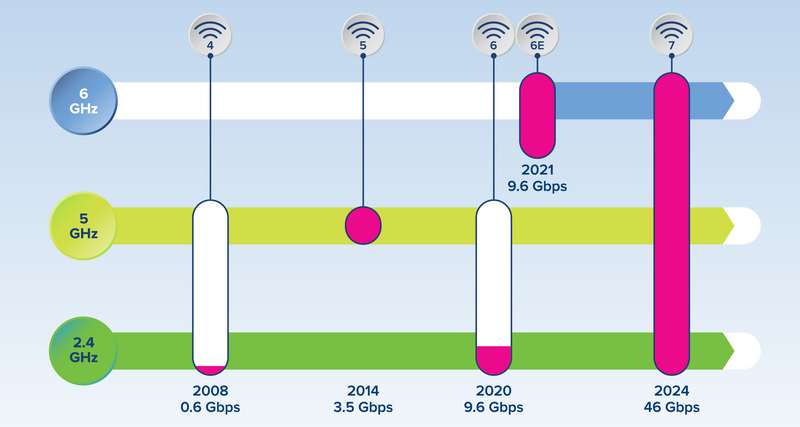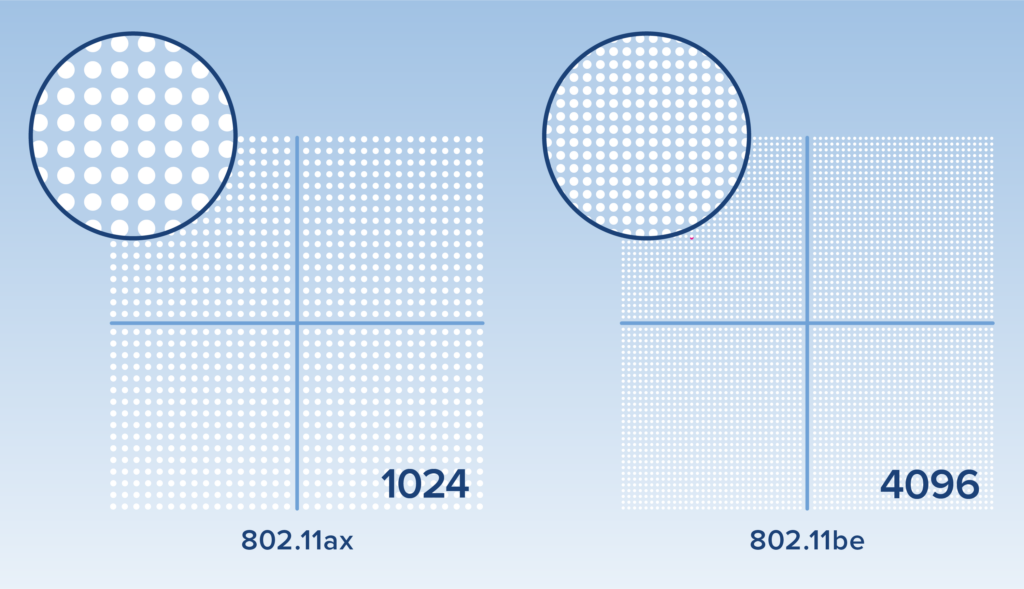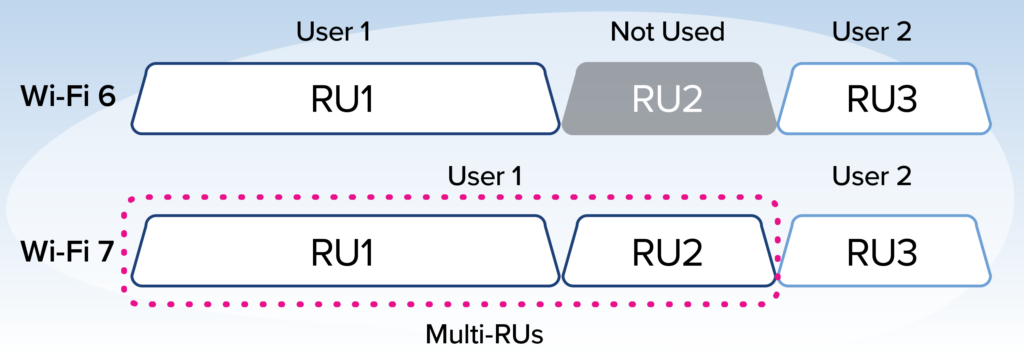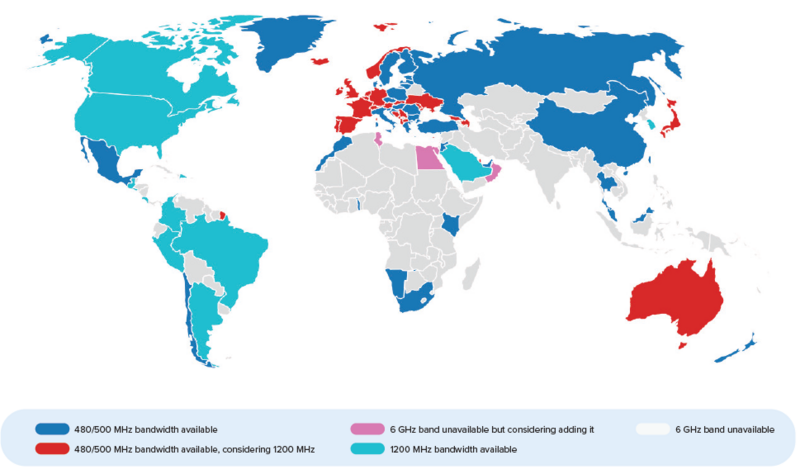Discover the Future of Wi-Fi 7 Technology
Wi-Fi 7 represents the seventh generation of Wi-Fi, based on the advanced IEEE 802.11be standard. Though the final standard will be ratified in late 2024, Wi-Fi 7 certification began early in 2024, and the first devices are already here. Enterprise networks are rapidly adopting this technology, setting a new benchmark for speed, reliability, and efficiency, enabling cutting-edge applications like AI Automation and Generative AI.

Why Wi-Fi 7?
Unmatched Speed and Efficiency
- Blazing Fast Speeds: 802.11be supports up to 46 Gbps, revolutionizing internet speed, perfect for data-intensive applications such as AI Automation.
- Enhanced Throughput: Wider channels, higher modulation (up to 4096-QAM), and support for up to 16 spatial streams mean up to 2x the throughput compared to Wi-Fi 6E.
Reliable and Low-Latency Connections
- Multi-Link Operation (MLO): Aggregate channels across frequency bands to reduce latency and improve reliability.
- Deterministic Latency: Features like Restricted Service Periods and Target Wait Times ensure minimal latency, perfect for real-time applications like AI-driven processes and virtual reality.
Widespread Band Utilization
- Tri-Band Support: Operates across 2.4 GHz, 5 GHz, and 6 GHz bands, optimizing performance for various applications and environments.
- Adaptive to Interference: Preamble Puncturing dynamically masks out interference, making efficient use of wider channels, ensuring smooth AI Automation tasks.
Key Features of Wi-Fi 7 for Enterprise
Multi-Link Operation
- Multi-Link Single Radio (MLSR): Switch channels to avoid congestion with a single radio.
- Enhanced Multi-Link Single Radio (eMLSR): A second radio listens for congestion, optimizing channel switching.
- Multi-Link Multi-Radio Simultaneous Transmit and Receive (MLMR-STR): Transmit and receive simultaneously on multiple radios for maximum efficiency.
- Multi-Link Multi-Radio Non-Simultaneous Transmit and Receive (MLMR-NSTR): Synchronized transmissions on two radios, balancing cost and performance.

Improved Throughput
- Wider Channels: Up to 320 MHz channels in the 6 GHz band.
- Higher Modulation: Up to 4096-QAM for a 20% increase in throughput.
- Multiple Spatial Streams: Up to 16, although most APs will use 4 or fewer.

Efficient Data Transmission
- Compressed Block-ack: Acknowledges up to 512 data units simultaneously.
- Multiple Resource Units (Multi RU): Assigns multiple channel chunks to a single client, improving efficiency.

Video: Cambium Networks’
Daran Hermans on Wi-Fi 7 for Enterprise
Video: Unboxing the
X7-35X Indoor Wi-Fi 7 Wireless Access Point
Deploying Wi-Fi 7 Enterprise Networks
To leverage the full potential, especially in the 6 GHz band:
- Design with Tri-Band APs: Ensure support for 2.4 GHz, 5 GHz, and 6 GHz bands.
- Optimize for Wider Channels: Utilize 80 MHz or 160 MHz channels for enterprise environments.
- Adopt AFC Systems: For indoor and outdoor 6 GHz usage, comply with Automatic Frequency Coordination (AFC) regulations.
Preparing for the Future
802.11be sets the stage for a new era of wireless connectivity. With enhanced speeds, lower latency, and robust reliability, it’s crucial to prepare your network for this transformative technology. As devices like the Google Pixel 8 and Samsung Galaxy S24 Ultra already support 802.11be, the adoption rate will accelerate through 2025. This technology is essential for applications in AI Automation and Generative AI, driving innovation forward.

When to Integrate Wi-Fi 7 Access Points in Your Network
Consider upgrading if you need higher throughput, lower latency, or better reliability, particularly for advanced applications like AR/VR or when using the 6 GHz band. The new standard offers significant improvements in efficiency and performance, making it ideal for congested environments or future-proofing your network for emerging devices.
- Faster Speeds: Up to 46 Gbps.
- Lower Latency: More reliable performance.
- Better Efficiency: Enhanced network features.
- AR/VR Ready: Optimized for advanced applications.
- Future-Proof: Prepares for upcoming devices.
- 6 GHz Optimization: Superior performance in the 6 GHz band.
What to Do Next?
Check out Cambium Networks’ Wi-Fi 7 access point: X7-35X Wi-Fi 7 Indoor Enterprise Wireless Access Point
SOLUTION PAGES
Enterprise Wi-Fi & Switching
Hospitality Network Solutions
Primary Education
Campus Connectivity
Multi-Dwelling Units
Wi-Fi Backhaul
MORE INFORMATION
- Press Release: Cambium Networks Introduces the First in a New Class of Enterprise Wi-Fi 7 Solutions
- Solution Paper: Discover the Future of Wi-Fi 7 Technology
- Blog: 3 Ways Wi-Fi 7 Will Transform Guest Experiences in Hospitality
- Blog: Weighing Whether to Shift to Wi-Fi 7? Read This First
- Webinar Replay: Discover the Future of WiFi 7 Technology in your Business Operations